By Brooke Twyford
This paper was provided courtesy of Australian National Maritime Museum volunteers. It was published in the June 2020 edition of ‘All Hands’, the Australian National Maritime Museum Volunteers’ Quarterly Newsletter. Through the close relationship between the Naval Historical Society and Australian National Maritime Museum stories are periodically shared for the mutual benefit of members.
As I gaze out over Iron Cove in ‘iso’, I regularly spy the welcome sight of a classic wooden Navy boat motoring back and forth from Spectacle Island to the public jetty at Birkenhead, Drummoyne. Spectacle Island is closed to the public except for those who are invited or granted access to visit for business purposes. I became curious to know more about the history of the launch that links the Naval Repository to the outside world.
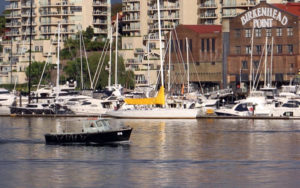
The island originally named Gongul by the Wangal aboriginal people became known as Spectacle Island in the early 1800s, most likely after the shape of the island before modification. Britain’s Royal Navy’s Australian Squadron opened an armament depot there in 1884, then it was transferred to the Commonwealth of Australia following Federation in 1901 and continued as the armament depot when the Commonwealth Naval Forces became the Royal Australian Navy (RAN) in 1911.
The 40-foot Australian Workboat, displaying the number 379 on the bow of her shiny black hull with a storm grey colour cabin, is a service vessel owned by the RAN and operated by Serco, a contractor specialising in defence support including vessel operations and maintenance.
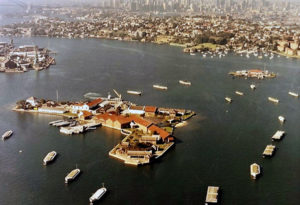
David Michael, President 0f the Naval Historical Society, confirmed that AWB 379 is steered by a number of coxswains on a roster system departing Garden Island boat pound each weekday around 06:30am and arriving back to the pound from Spectacle Island around 15:30pm. As the boat cannot lie alongside a public wharf it arrives just before the hour and departs on the hour back to Spectacle Island. The first run of the day commences at 07:00am from Drummoyne and subsequent runs depart Spectacle Island at 15 minutes to the hour and the last is at 14:45pm.
The run’s history can be traced back to the early 1900s not long after the RAN took over Spectacle Island from Britain’s Royal Navy. The original “run” linked Spectacle Island, Drummoyne, Newington Armory, Cockatoo Island, Garden Island and Circular Quay. It incorporated the then active navy yards in Sydney including the UNESCO world heritage site Cockatoo Island dockyard which closed in 1991 and the heritage armament depot at Newington Armory in Homebush Bay, which closed in 1999 ahead of the 2000 Olympic Games.
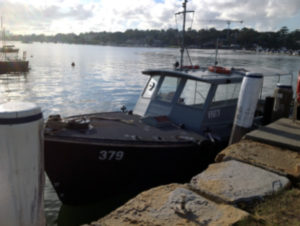
The history of the boat itself dates to 1966, when Lars Halvorsen Sons Pty Ltd of Sydney designed and built it on spec as a one-off to replace “WWII 40-footers,” which were designed by Botterill and Fraser of Melbourne to support Allied operations in the islands north of Australia. Of the 400 produced, many have since become collector’s items, with some restored to their original form and others turned into pleasure craft. While guiding visitors on SY Ena just before the shutdown, I was lucky enough to meet the proud owners of a workboat now located in the Whitsundays.
The new boat was first launched in 1967 to serve as a tender for the trials of the 12-metre America’s Cup contender Gretel 11 (see ARHV) which was owned by media mogul Sir Frank Packer and syndicate. Five years before that, Gretel became the first Australian yacht to challenge the New York Yacht Club for the America’s Cup; previously only Great Britain and Canada had taken it on. Although Gretel lost 4-1 that year, she became the first yacht since the 1930s to beat the Americans in a single race. Gretel II was the last Cup boat with a wooden hull, rather than made of aluminium or fibreglass, to contest the America’s Cup challenge series in 1970. It wasn’t until 1983 that Australia won the Cup with a winged keel hull ending 132 years of US domination. Today’s competitors, which will next sail in the 36th America’s Cup Match in New Zealand from 6 to 21 March 2021, are shaped from high tech materials and are foiling monohulls.
The RAN procured the tender as soon as it returned from the America’s Cup trials, and she became known as AWB4011. The 40 prefix is a direct reference to the size of the boat. Slightly different from standard Australian workboats, with a flare at the stern and no forward coach house, it was used for defence and civilian passengers and cargo transport as well as assisting large “ammunition lighters”, a flat-bottomed barge used in loading and unloading naval ships and transporting goods for short distances. “Lighter” is possibly derived from an old Dutch or German word, lichten (to lighten or unload).
Clive Sewell, who was recently recognised by Serco for 50 years of service as a Tug Master and currently works in the Dockyard at Garden Island, recalls his time at the helm of AWB4011 as one of his favourite years, filled with his most cherished memories. “It was a time when you looked after your charge as if it were your own, always polishing the brass,” says Sewell, who dubbed the boat Sobraon after the 1800s clipper, because of his admiration for full-rig ships.
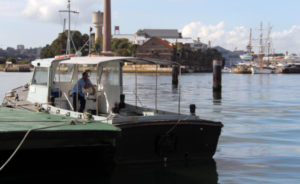
The original engine was a Cummins NH2 20 diesel, which gave the boat a lot of power. “There was only one way to drive it and it would throw a huge wash,” says Sewell. “You would see her coming.” The cockpit alone was big enough to carry a small car. Sewell never ferried a car in the boat, but he did count admirals and commodores among his passengers. And his most prized cargo? A full pallet of beer!
Having served through the end of the steam tug era, the introduction of diesel tugs and the launch of other propulsion units on the water today, Sewell remains passionate about the job. “Honestly some days I’ve been frightened and cold but I’ve still enjoyed every day.”
In the mid 2000s, AWB4011 was reassigned and refurbished to put seats in it specially to do the run it continues to do today and the hull number change to 379 happened when it changed service providers. It is now an asset number rather than a pennant number.
David Glasson who is a model-maker and master of many things marine, has conducted extensive research on Australian workboats, along with Mori Flapan, naval architect, author and administrator of boatregister.net, where a plethora of information about workboats’ history can be found. According to Glasson, as many as eight workboats were to go on display at this year’s Classic and Wooden Boat Festival, which was due to be hosted by the Museum during the first weekend in May before it was Covid 19 cancelled. Let’s hope we get to see those beauties in 2021.
In the meantime, AWB 379 will continue to be a welcome sight in my daily life, and a reminder to Sydneysiders of a storied era in Australia’s past.
Notes:
For more information about Gretel and Gretel II, see the Australian Register of Historic Vessels: https://www.sea.museum/discover/arhv
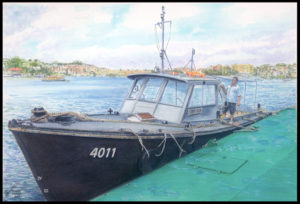
Artwork titled Australian Work Boat 4011 ‘Sobraon’ at Spectacle Island, Sydney
Credit: Victoria Kitanov copyright 2017.
From 2016 to 2019, Victoria Kitanov was an archivist on Spectacle Island. She documented her time travelling back and forth on tender 379 in photographs. From archivist to artist, her passion is painting naval heritage reconstructed from the photos taken around Spectacle Island. She painted the original pennant number 4011 and ‘Sobraon’ in this painting as a historical tribute. To view her other works, visit https://www.victoriakitanovfineart.com.au/.




